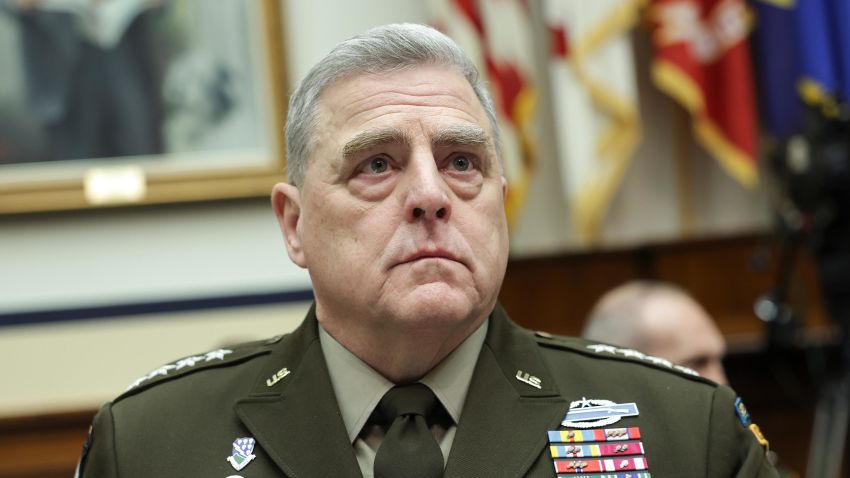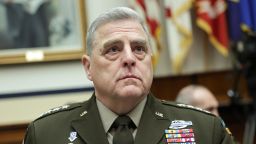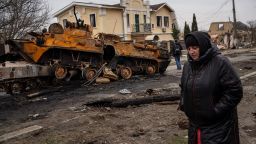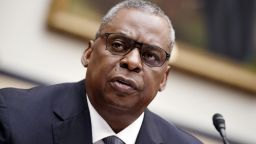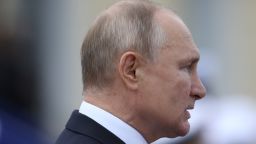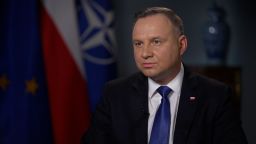The top US military general this week endorsed creating permanent US bases in Eastern Europe as a response to Russia’s attack on Ukraine, saying that American bases on NATO’s eastern flank would act as a deterrent to Moscow.
The comments from Chairman of the Joint Chiefs Gen. Mark Milley were the most public indication to date of how the Biden administration could fundamentally alter the US security presence in Eastern Europe in order to reassure nervous NATO allies following Russia’s attack on Ukraine.
But Milley’s recommendation came with a twist: He said he didn’t think the US needed to permanently station troops at those bases to create an effective deterrent.
“I believe a lot of our European allies, especially those such as in the Baltics or Poland or Romania or elsewhere, they are very, very willing to establish permanent bases,” Milley said to lawmakers during congressional testimony. “They’ll build them, they’ll pay for them, etc., for us to cycle through on a rotational basis. So you get the effect of permanent presence of forces, but the actual individual soldiers, sailors, airmen or Marines are not permanently stationed there for 2-3 years.”
Milley’s assessment reflects the balance the Biden administration is aiming to strike as it works within the NATO alliance to bolster European security – while keeping a sharp focus on the threat posed by China in the Pacific.
The Pentagon’s $773 billion budget proposal released last week indicates how the US military still sees China as its primary strategic challenge. While the budget was largely prepared before Russia’s invasion, Deputy Defense Secretary Kathleen Hicks said last week that the budget “prioritizes China as the pacing challenge” while it recognizes the “acute threat posed by Russia.”
The two countries pose different threats: China’s economy is significantly larger than Russia’s, with economic power to challenge the United States directly, though it’s still unclear how willing Beijing would be to use its rapidly expanding military in conflict with another major country. Russia, however, has shown a willingness to use its military to achieve its aims – the full-scale invasion of Ukraine comes after previous military incursions into both Ukraine and Georgia.
“We’re in the midst of a change from two decades of counterinsurgency to near-peer competition. The thought was that the only major competition would be China, but now we’re looking at two main competitors,” Senate Armed Services Chairman Jack Reed, a Rhode Island Democrat, told CNN.
It’s too soon to say whether the tens of thousands of new US forces that have deployed to Europe over the past two months mark the beginning of a permanent expanded US presence on NATO’s eastern flank to try to prevent future Russian aggression – or if the current focus on Europe will subside when the war ends, returning the US military’s primary attention toward the Pacific.
Still, US and NATO officials say things will never go back to the way they were before Russian President Vladimir Putin attacked Ukraine, which sparked the biggest land war in Europe since World War II. The surge of military forces into Eastern Europe – and the weapons freely flowing from NATO countries to Ukraine to be used in the fight against Russian forces – have kicked off what’s likely to be long-term commitments to security and spending from numerous NATO countries.
Military and Pentagon officials, lawmakers and military experts say that while NATO is doing its best to stay directly out of Russia’s war in Ukraine, the alliance is going to have to make key decisions over whether it should act in ways that risk escalating tensions with Russia, such as admitting new members like Sweden or Finland. Last month, Moscow threatened both countries against joining NATO.
Defense Secretary Lloyd Austin told the Senate Armed Services Committee on Thursday that the US is discussing with NATO what has changed since Russia’s attack on Ukraine and how to account for it.
“This unlawful and unprovoked aggression by Putin has the effect of changing the security architecture in the region for some time to come,” Austin said. “We do expect that it will change our footprint. In terms of how much it changes the US contribution, that’s left to be seen.”
‘It’s a wake-up call’
The decisions the Biden administration makes regarding US security posture toward Russia will chart the direction of a military that’s pivoting from 20 years of Middle Eastern wars and counterinsurgency to a new phase focused on military competition with China and Russia. The degree to which the military turns its focus to Europe could help determine the future of an Army that’s slated to shrink slightly in the next year and a Marine Corps whose future role in the US military is now the subject of considerable debate as it readies a reorganization.
“I do think this is a very protracted conflict,” Milley said of the war in Ukraine. “And I think it’s at least measured in years, I don’t know about decade, but at least years, for sure. This is a very extended conflict that Russia has initiated.”
Austin has been adding troops and assets to the region since Russia’s invasion, increasing the overall number of US troops in Europe from 60,000 to about 100,000.
Gen. Tod Wolters, commander of US European Command, said during a congressional hearing last week that the Russian invasion is an unfortunate catalyst for an overdue reevaluation of the permanent military presence on the continent.
“It’s got to change, and certainly this is an opportunity as a result of this senseless act on behalf of Russia to reexamine the permanent military architecture that exists not only in Eastern Europe, but in our air policing activity in aviation and in our standing naval maritime groups,” Wolters said.
Mark Cancian, a retired Marine colonel and a senior adviser at the Center for Strategic and International Studies, said the Biden administration’s initial inclination before the Ukraine war to focus primarily on China is likely to shift.
“I think there was a very strong sense in their strategy that China was the ‘pacing threat,’ as they called it – everything else would have to be secondary,” he said. “Now that’s clearly not the case.”
House Armed Services Chairman Adam Smith, a Washington state Democrat, said he didn’t think that an added emphasis on Russia needed to come at the expense of countering China. “I think we can do both. That’s what the budget debate and the defense strategy debate is going to be about,” Smith told CNN. “I think it’s pretty clear that we’re ready for a more robust force posture in Eastern Europe with our NATO partners, without question.”
Republicans have accused the Biden administration of shortchanging its proposed 2023 Pentagon budget, which would increase by roughly $30 billion compared with the current fiscal year, saying more funding is needed in part to provide better deterrence against Russia.
“It’s a wake-up call,” said Sen. Jim Inhofe of Oklahoma, the top Republican on the Senate Armed Services Committee. “There’s still a lot of liberal people around who don’t think there’s any real threat out there. I think that has done away with that.”
A larger permanent European presence
US officials say Putin miscalculated how NATO would respond to Russian aggression in Ukraine. Projecting unity, European countries that rely on Russian energy joined in on crippling sanctions against Moscow, and several countries that had previously been on the sidelines have provided weapons to Ukraine.
It’s a notable shift from President Donald Trump’s time in office, when he questioned the value of the alliance, claiming members were not contributing enough defense funds, and when he pushed to withdraw US troops from Germany.
But the alliance still faces hard, potentially fractious, choices ahead.
While Ukraine has seemingly put off the prospect of joining NATO, other countries like Sweden and Finland could be incentivized to do so, fearing the prospect of widening Russian aggression and seeking the protection of the alliance’s Article 5 commitment to defend member countries from attack. NATO Secretary General Jens Stoltenberg said on CNN’s “State of the Union” Sunday that both Finland and Sweden could be welcomed into the alliance if they want to do so.
“We have a good dialogue with the Finnish political leadership, with the Finnish President, also with Sweden,” Stoltenberg said. “And, of course, it’s for them to decide. But if they apply, I expect that they will be very much welcomed by all 30 allies, and that we will find ways to do that in a relatively quick way, to take them into the alliance, if they so want.”
Michael O’Hanlon, a senior fellow at the Brookings Institution, said Russia’s aggression has “refocused” NATO on promoting the security of its core countries. “NATO in some ways finds its original purpose, and in some ways becomes an easier organization to hold together,” he said.
Since the beginning of Russia’s invasion, NATO has agreed to establish four more battle groups in Bulgaria, Hungary, Romania and Slovakia. Those forces add to the battle groups that were established by NATO in 2017 in Estonia, Latvia, Lithuania and Poland, meaning NATO now has forces deployed all along its Eastern European flank.
Battle groups are military forces from different NATO countries that train and are stationed together so that, if a conflict arises, they are prepared as a united NATO force.
Wolters, who also serves as NATO’s supreme allied commander Europe, said during last week’s hearing that he believes a new US military presence on the continent will be strongly supported by NATO allies.
This week, Austin approved the extension of deployments of US military members from the 82nd Airborne Division in Poland, about 7,000 troops and their support elements, and the USS Harry S Truman carrier strike group stationed in the Mediterranean. Pentagon spokesman John Kirby said both groups will stay “for a while longer,” during a news briefing last week.
“No matter how this war ends, no matter when it ends, the security environment in Europe is going to be different. And we’re going to have to respond to that,” Kirby said. “But we’re going to stay open to having those kinds of conversations too, about whether there needs to be … a larger permanent presence on the European continent.”
CNN’s Oren Liebermann contributed to this report.



